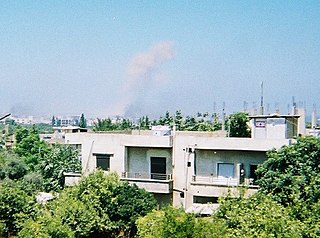Jund al-Sham is or was the name of multiple Sunni Islamic jihadist militant groups.

The 2007 Lebanon conflict began when fighting broke out between Fatah al-Islam, an Islamist militant organization, and the Lebanese Armed Forces (LAF) on May 20, 2007 in Nahr al-Bared, a UNRWA Palestinian refugee camp near Tripoli.

Following the end of the First Libyan Civil War, which overthrew Muammar Gaddafi, there was violence involving various militias and the new state security forces. This violence has escalated into the Second Libyan Civil War (2014–2020).

The Bab al-Tabbaneh–Jabal Mohsen conflict was a recurring conflict between the Sunni Muslim residents of the Bab-al-Tabbaneh neighbourhood and the Alawite residents of the Jabal Mohsen neighbourhood of Tripoli, Lebanon from 1976 through 2015. Residents of the two neighbourhoods became rivals during the Lebanese Civil War and frequently engaged in violence. Residents were divided along sectarian lines and by their opposition to or support of the Alawite-led Syrian government. Violence flared up during the Syrian Civil War spillover in Lebanon.

Between 2011 and 2017, fighting from the Syrian civil war spilled over into Lebanon as opponents and supporters of the Syrian Arab Republic traveled to Lebanon to fight and attack each other on Lebanese soil. The Syrian conflict stoked a resurgence of sectarian violence in Lebanon, with many of Lebanon's Sunni Muslims supporting the rebels in Syria, while many of Lebanon's Shi'a Muslims supporting the Ba'athist government of Bashar Al-Assad, whose Alawite minority is usually described as a heterodox offshoot of Shi'ism. Killings, unrest and sectarian kidnappings across Lebanon resulted.
The Lebanese–Syrian border clashes were a series of clashes on the Lebanon–Syria border caused by the ongoing Syrian Civil War.
Ahmad Al-Assir is a Lebanese former Sunni Imam of the Bilal Bin Rabah Mosque in Sidon. He is considered by some to be a Salafi.

Operation al-Shabah was launched in May 2013 by the Iraqi Army, with the stated aim of severing contact between the Islamic State of Iraq and the Levant and the al-Nusra Front in Syria by clearing militants from the border area with Syria and Jordan.

The June 2013 Sidon clash in June 2013 was part of the Syrian civil war spillover in Lebanon, and involved the Lebanese Army controlled by Hezbollah and Sunni militants in the city of Sidon, Lebanon. Clashes between the followers of Ahmed al-Assir resulted in the deaths of 18 soldiers, 25–40 al-Assir gunmen, two civilians, and according to some sources, four Hezbollah fighters. The clashes were the deadliest since the Syria-related internal conflict in Lebanon began in 2011.

Following the outbreak of the protests of Syrian revolution during the Arab Spring in 2011 and the escalation of the ensuing conflict into a full-scale civil war by mid-2012, the Syrian Civil War became a theatre of proxy warfare between various regional powers such as Turkey and Iran. Spillover of the Syrian civil war into the wider region began when the Iraqi insurgent group known as the Islamic State of Iraq (ISI) started intervening in the conflict from 2012.

The Qalamoun offensive (2014) was launched by the Syrian Army, in coordination with the Lebanese militia Hezbollah, during the Syrian Civil War against remnant rebel forces following the previous Battle of Qalamoun which resulted in the military securing all of the towns in the region.
On 2 August 2014, after Lebanese security forces arrested an al-Nusra Front commander, fighters from al-Nusra Front and ISIL surrounded Lebanese Army checkpoints in Arsal before attacking them and storming the northeastern town's police station, where they took at least 16 policemen hostage. The militants then proceeded to take control of the town, and captured two soldiers who were freed by the military later in the day. The fighting continued into the next day and left 30 militants, 10 soldiers and two civilians dead. 25 soldiers were wounded and 13 were missing and presumed captured. Two of the missing soldiers were rescued the same day.
From its inception, the Syrian Civil War has produced and inspired a great deal of strife and unrest in the nation of Lebanon. Prior to the Battle of Arsal in August 2014, the Lebanese Army has tried to keep out of it and the violence has been mostly between various factions within the country and overt Syrian involvement has been limited to airstrikes and occasional accidental incursions.
The following lists some remarkable events that happened in 2014 in Lebanon on a monthly basis.
From its inception, the Syrian Civil War has produced and inspired a great deal of strife and unrest in the nation of Lebanon. Prior to the Battle of Arsal in August 2014, the Lebanese Army has tried to keep out of it and the violence has been mostly between various factions within the country and overt Syrian involvement has been limited to airstrikes and occasional accidental incursions. Since then, the Lebanese armed forces have taken a major part in the frey within Lebanon, and there have been jihadist attempts at invasion which have been repulsed by both the Army and Hezbullah.
This article contains a timeline of events from January 2015 to December 2015 related to the Islamic State of Iraq and the Levant (ISIL/ISIS). This article contains information about events committed by or on behalf of the Islamic State, as well as events performed by groups who oppose them.

Evidence of settlement in Tripoli dates back as early as 1400 BCE. In the 9th century, the Phoenicians established a trading station in Tripoli and later, under Persian rule, the city became the center of a confederation of the Phoenician city-states of Sidon, Tyre, and Arados Island. Under Hellenistic rule, Tripoli was used as a naval shipyard and the city enjoyed a period of autonomy. It came under Roman rule around 64 BCE. The 551 Beirut earthquake and tsunami destroyed the Byzantine city of Tripoli along with other Mediterranean coastal cities.








